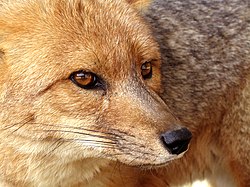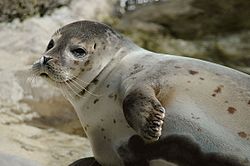Whiskers: Difference between revisions
no refs given for this, until one is given it should really stay out. |
|||
| Line 13: | Line 13: | ||
A large part of the [[brain]] of many mammals is devoted to processing the nerve impulses from vibrissae because it is important to their survival. Information from the vibrissae is transmitted and processed through the [[trigeminal nerve]] into the [[brainstem]] and [[thalamus]] before relaying to the [[barrel cortex]] of the brain. Mammals use a great deal of energy to keep the follicles housing their whiskers warm and ready to use. Some animals - mainly [[rodents]] - actively palpate their vibrissae, a process known as whisking, whilst others use them merely as passive sensors. |
A large part of the [[brain]] of many mammals is devoted to processing the nerve impulses from vibrissae because it is important to their survival. Information from the vibrissae is transmitted and processed through the [[trigeminal nerve]] into the [[brainstem]] and [[thalamus]] before relaying to the [[barrel cortex]] of the brain. Mammals use a great deal of energy to keep the follicles housing their whiskers warm and ready to use. Some animals - mainly [[rodents]] - actively palpate their vibrissae, a process known as whisking, whilst others use them merely as passive sensors. |
||
Clipping or otherwise removing a mammal's vibrissae deprives the affected animal of sensory awareness. For example, cutting off the vibrissae on one side of a housecat's face will cause it to cut left corners too quickly and walk in a lopsided manner until the vibrissae grow back.{{Fact|date=September 2008}} |
|||
==References== |
==References== |
||
Revision as of 20:44, 11 October 2008



Vibrissae (singular: vibrissa), or whiskers, are specialized hairs, usually employed for tactile sensation, but can also refer to the stiff feathers near the mouths of some birds. Vibrissae hairs commonly grow around the nostrils, above the lips, and on other parts of the face of most mammals, as well as on the forelegs and feet of some animals. Vibrissae are usually thicker and stiffer than other types of hair.[1][2]

Vibrissae consist of inert material and contain no nerves, but do have special sensory cells associated with them.[1] Vibrissae are different from other hairs mainly because they are implanted in a special follicle sealed by a capsule of blood, called a blood sinus. Touching a vibrissa causes it to bend, and the blood in the sinus is pushed to one side or the other. The blood amplifies the movement and allows the mechanoreceptors at the base of the vibrissa to detect extremely small deflections.[3]
In some mammals, the follicles of vibrissae are surrounded by a highly developed sheath of muscle tissue which can be used to move them, such as in the case of whiskers found on cats, dogs and other mammals. Whiskers can grow to be extremely long; the length of a chinchilla's whiskers can be up to a third of its body length.
Vibrissae offer an advantage to animals that do not always have sight to rely on to navigate or to find food, or when the usefulness of non-tactile senses is limited. Some animals, such as house mice, can even detect air movements with their vibrissae.
A large part of the brain of many mammals is devoted to processing the nerve impulses from vibrissae because it is important to their survival. Information from the vibrissae is transmitted and processed through the trigeminal nerve into the brainstem and thalamus before relaying to the barrel cortex of the brain. Mammals use a great deal of energy to keep the follicles housing their whiskers warm and ready to use. Some animals - mainly rodents - actively palpate their vibrissae, a process known as whisking, whilst others use them merely as passive sensors.
References
- ^ a b Weldon Owen Pty Ltd. (1993). Encyclopedia of animals - Mammals, Birds, Reptiles, Amphibians. Reader's Digest Association, Inc. pg. 18. ISBN 1875137491.
- ^ Vibrissa, medical-dictionary.thefreedictionary.com, undated (accessed 20 January,2007)
- ^ Hair, animaldiversity.ummz.umich.edu, undated (accessed 20 January,2007)
